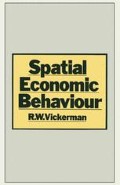Abstract
We have been critical of general equilibrium approaches to the urban system on two grounds — the problems of handling continuous variables simultaneously in both space and time dimensions, and the relevance of a dynamic path based on sequences of temporary equilibria. In this chapter we outline some operational alternatives to the general equilibrium approach and discuss their relevance to our primary aim of understanding and evaluating economic behaviour in a spatial economy.
Access this chapter
Tax calculation will be finalised at checkout
Purchases are for personal use only
Preview
Unable to display preview. Download preview PDF.
References
Baumol, W. J. (1967), ‘Macroeconomics of unbalanced growth: the anatomy of urban crisis’, American Economic Review, 47, 415–26.
Borts, G. H. (1960), ‘The equalisation of returns and regional economic growth’, American Economic Review, 50, 319–47.
Day, R. H. (1973), ‘Recursive programming models: a brief introduction’, in G. G. Judge and T. Takayama (eds.), Studies in Economic Planning over Space and Time (Amsterdam: North Holland).
Day, R. H. (1975), ‘Adaptive processes and economic theory’, in R. H. Day and T. Groves (eds.), Adaptive Economic Models (New York: Academic Press).
Day, R. H., and Cigno, A. (eds.) (1978), Modelling Economic Change: the Recursive Programming Approach (Amsterdam: North Holland).
Devletoglou, N. E. (1971), Consumer Behaviour (London: Harper & Row).
Dixon, R., and Thirlwall, A. P. (1975), ‘A model of regional growth rate differences on Kaldorian lines’, Oxford Economic Papers, 27, 201–14.
Friedman, J. (1973), Urbanisation, Planning and National Development (Beverly Hills, Cal.: Sage).
Hartman, L. M., and Seckler, D. (1967), ‘Towards the application of dynamic growth theory to regions’, Journal of Regional Science, 7, 167–73.
Hartwick, P. G., and Hartwick, J. M. (1974), ‘Efficient resource allocation in a multi-nucleated city with intermediate goods’, Quarterly Journal of Economics, 88, 340–52.
Harvey, D. (1973), Social Justice and the City (London: Edward Arnold).
Herbert, J. D., and Stevens, B. H. (1960), ‘A model for the distribution of residential activities in urban areas’, Journal of Regional Science, 2, 21–36.
Holland, S. (1976), Capital Versus the Regions (London: Macmillan).
Kaldor, N. (1966), Causes of the Slow Rate of Growth of the United Kingdom (Cambridge: Cambridge U.P.).
Kaldor, N. (1970), ‘The case for regional policies’, Scottish Journal of Political Economy, 17, 337–47.
Lowry, I. S. (1964), A Model of Metropolis (Santa Monica: RAND Corporation).
Mills, E. S. (1972), ‘Markets and efficient resource allocation in urban areas’, Swedish Journal of Economics, 74, 100–13.
Myrdal, G. (1957), Economic Theory and Underdeveloped Regions (London: Duckworth).
Oates, W. E., Howrey, E. P., and Baumol, W. J. (1971), ‘The analysis of public policy in dynamic urban models’, Journal of Political Economy, 79, 142–53.
Perroux, F. (1955), ‘Note sur la notion de pôle de croissance’, Economie Appliquée, 7, 307–20.
Richardson, H. W. (1973), Regional Growth Theory (London: Macmillan).
Simon, H. A. (1959), ‘Theories of decision making in economics’, American Economic Review, 49, 253–83.
Vickerman, R. W. (1979), ‘The evaluation of urban change: equilibrium and adaptive approaches’, Urban Studies, 16, 81–93.
Wilson, A. G. (1974), Urban and Regional Models in Geography and Planning (London: Wiley).
Author information
Authors and Affiliations
Copyright information
© 1980 R. W. Vickerman
About this chapter
Cite this chapter
Vickerman, R.W. (1980). Beyond General Equilibrium. In: Spatial Economic Behaviour. Palgrave Macmillan, London. https://doi.org/10.1007/978-1-349-04384-2_7
Download citation
DOI: https://doi.org/10.1007/978-1-349-04384-2_7
Publisher Name: Palgrave Macmillan, London
Print ISBN: 978-1-349-04386-6
Online ISBN: 978-1-349-04384-2
eBook Packages: Palgrave Economics & Finance CollectionEconomics and Finance (R0)

